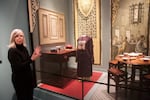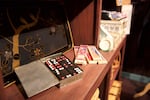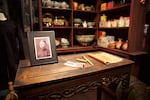
Museum curator Jacqueline Peterson-Loomis is a retired historian. She said about $1 million was spent to renovate the building and open the museum.
Kristian Foden-Vencil / OPB
The Portland Chinatown Museum opened this December with the aim of illustrating the seldom-told story of Chinese Americans in the Pacific Northwest.
It's not a big museum and it's only open Thursday through Sunday — in the afternoons. But visitors can learn a lot about Portland's history as they walk through.

The museum has hundreds of Chinese American artifacts, many donated by local families.
Kristian Foden-Vencil / OPB
The exhibit called 'Beyond The Gate' was first displayed by the Oregon Historical Society in 2016. The director there, Kerry Tymchuck, said it uses old Chinese opera costumes, rare artifacts, theatrical sets and texts to tell the story of contact and trade between China and the West — particularly in Portland.
“The role of the museum is not to be the Chamber of Commerce, not to be the tourism capital. It’s to tell the truth. And they tell the truth in this exhibit. And the truth can sometimes be ugly. And it was ugly here for many years towards the Chinese Americans. There was a great amount of discrimination,” said Tymchuck.

The museum has several dioramas that build a picture of a Chinatown restaurant, laundry and lottery.
Kristian Foden-Vencil / OPB
Jacqueline Peterson-Loomis is a retired historian and curator of the new museum. She said about $1 million was spent to renovate and open the building.
The next goal, she said, is to pivot into a capital campaign to purchase the building. They've been offered an option to buy it at a fixed price. But they need to raise the money within two years.
"So now we have to build an audience," she said.

Visitors get an idea of what some stores in Chinatown used to look like.
Kristian Foden-Vencil / OPB
Peterson-Loomis said the museum is both a labor of love and a risky bet. She said the whole thing was put together by mostly Chinese American families, some fourth and fifth generation, who consider Portland to be their cultural home.
"One of the things that was so sweet, I thought, in the last month or two was listening to these elders say: 'You know, we wanted this for so long and we thought it was for us. But it's not for us. It's for our grandchildren,'" said Peterson-Loomis.
By the end of the 19th century, Portland’s Chinatown was second only in size to that of San Francisco.
An annual family membership to the museum is $75.
